Abstract
When polymorphonuclear leukocytes (PMNL) and soluble or particulate matter interact, the cells produce chemiluminescence, linked to activation of the oxidative metabolism of the cells. PMNL isolated from a patient with a myeloperoxidase deficiency were found to produce almost no luminol-dependent chemiluminescence, despite a pronounced production of superoxide anions (O2-). The chemotactic peptide formylmethionyl-leucyl-phenylalanine induced a two-peak chemiluminescence response in control PMNL. The response was modified, both in magnitude and in time-course, when the cells were incubated at 22 degrees C for 120 min. Addition of purified myeloperoxidase to the PMNL lacking this enzyme, before stimulus addition, resulted in a chemiluminescence response. In the response to formylmethionyl-leucyl-phenylalanine, only one peak, corresponding to the initial peak of control PMNL, was found. This indicated that luminol-dependent chemiluminescence is dependent on and directly related to the presence of myeloperoxidase in PMNL and that both intra- and extracellularly located myeloperoxidase has to be taken into account when interpreting the cellular response assayed as chemiluminescence.
Full text
PDF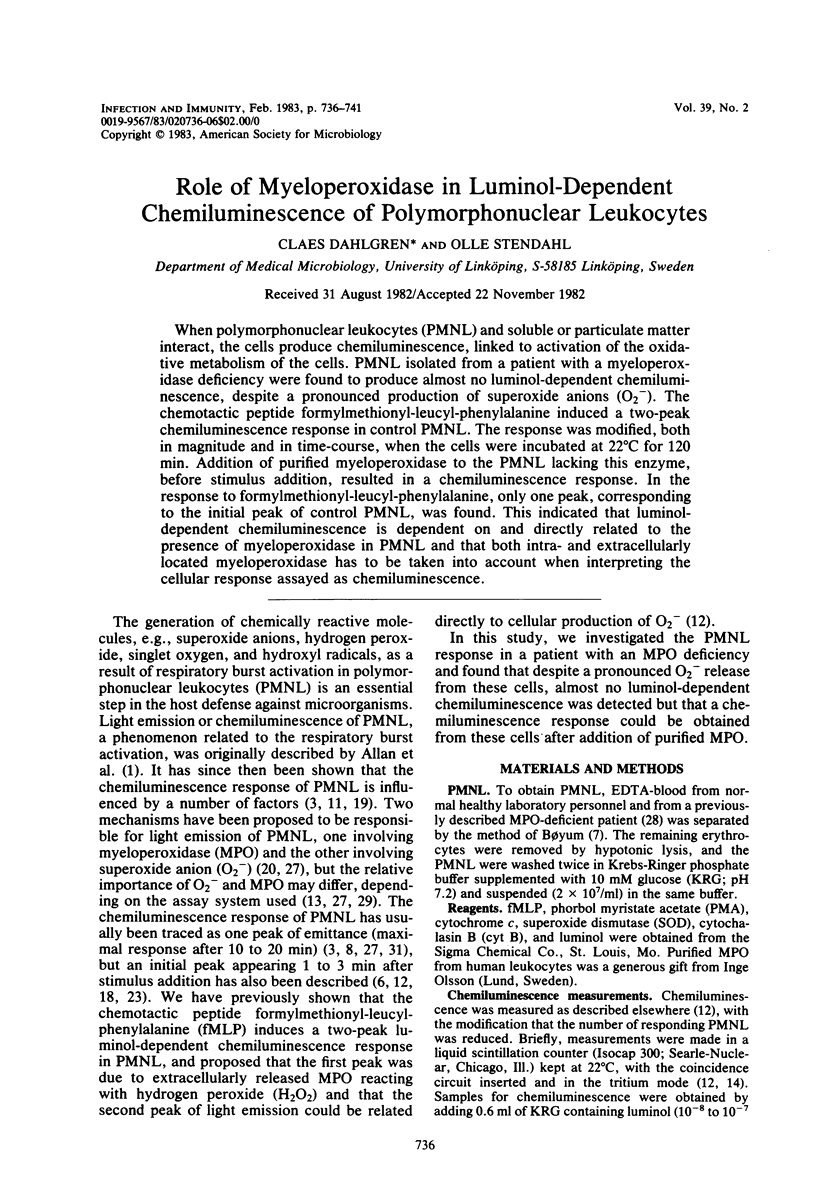
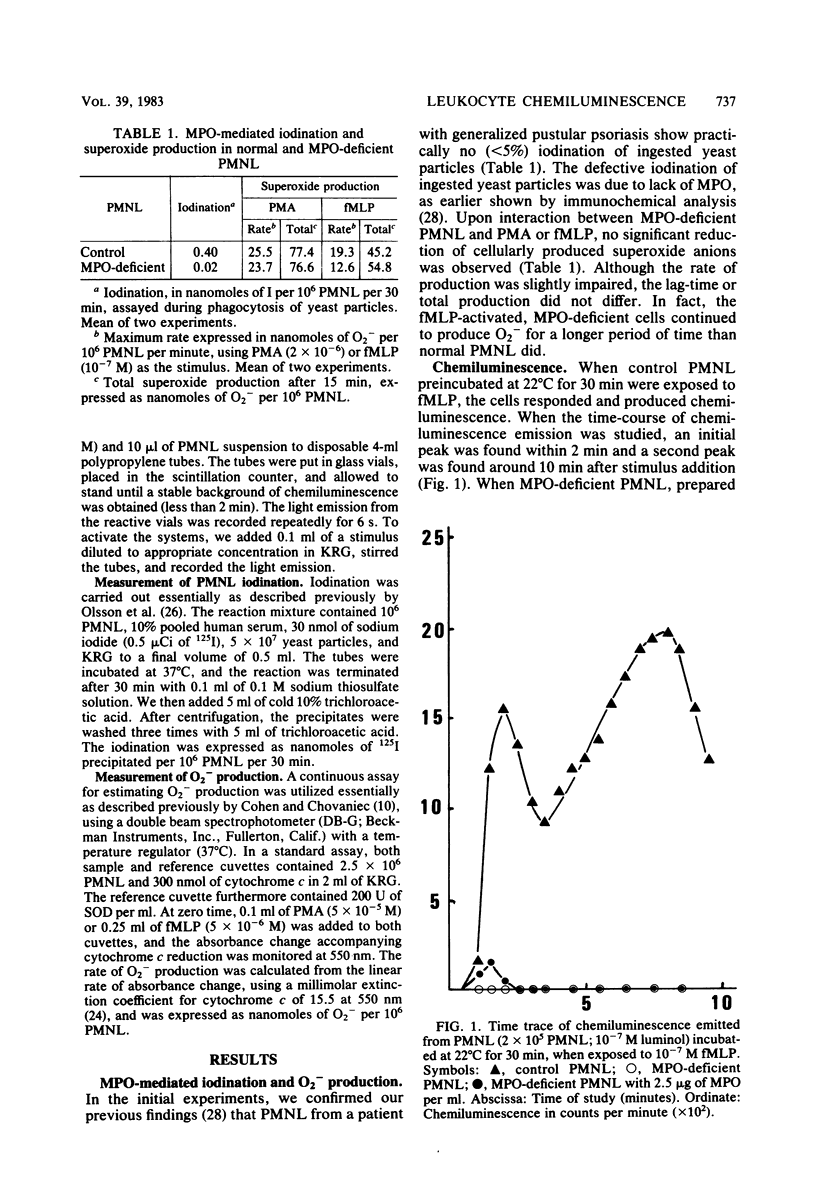
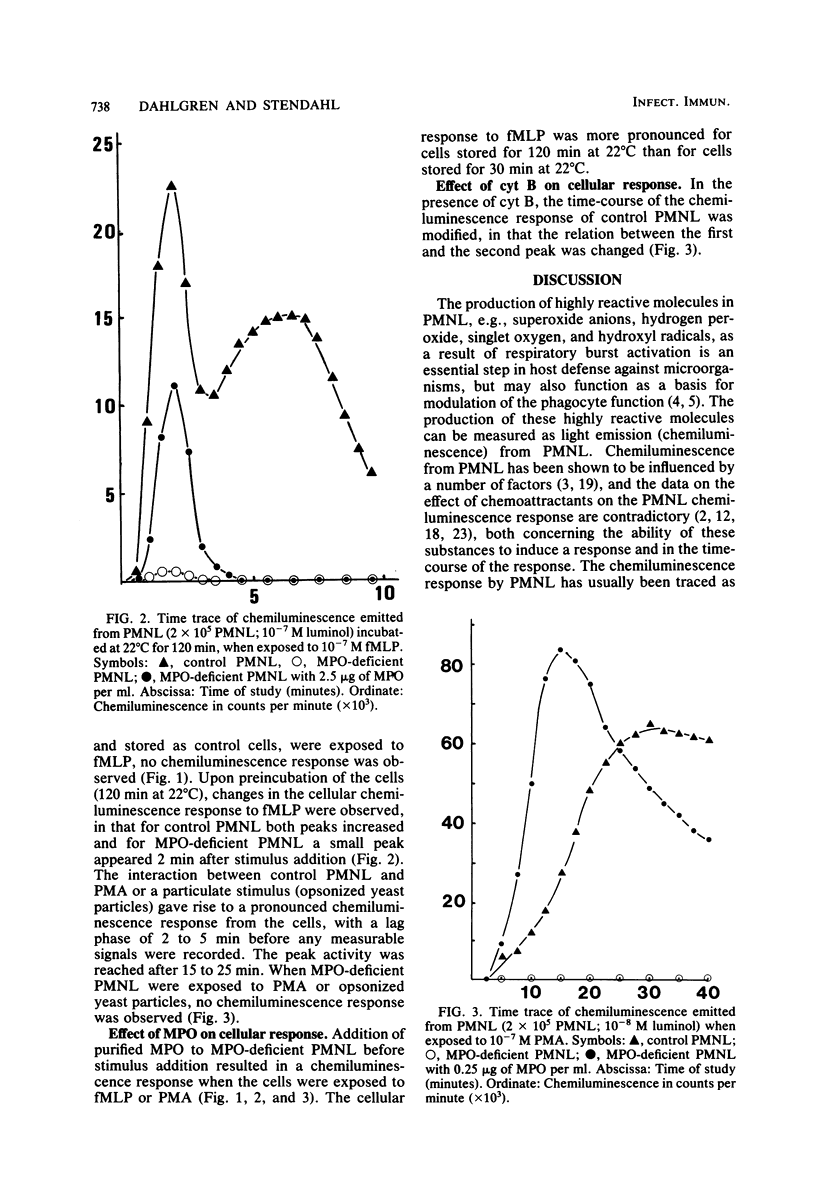
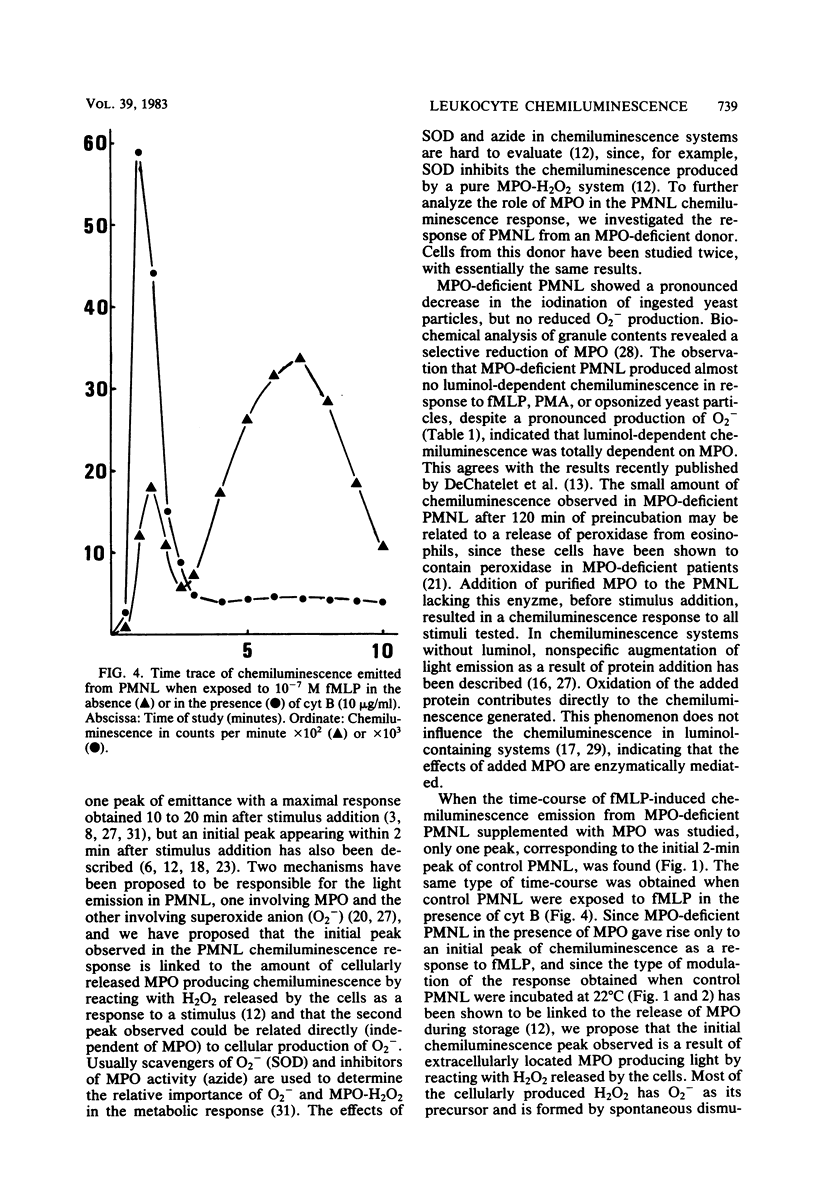
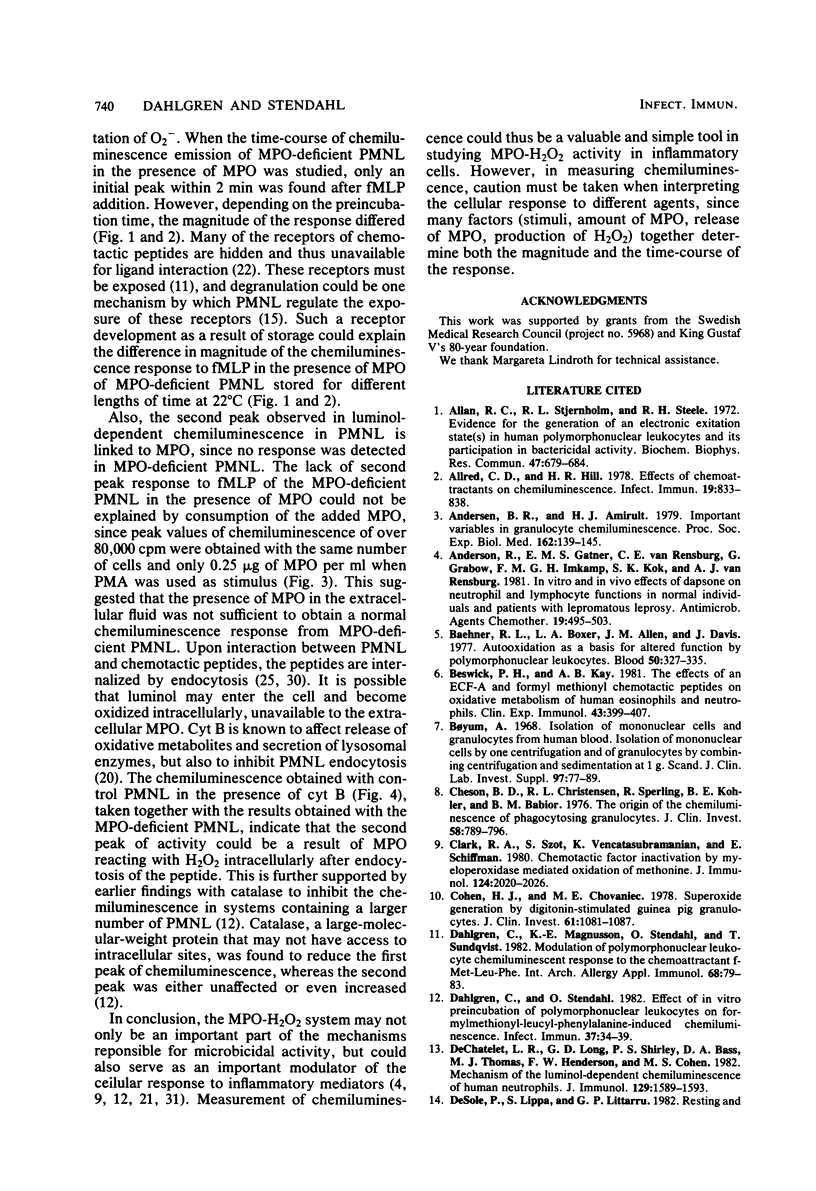
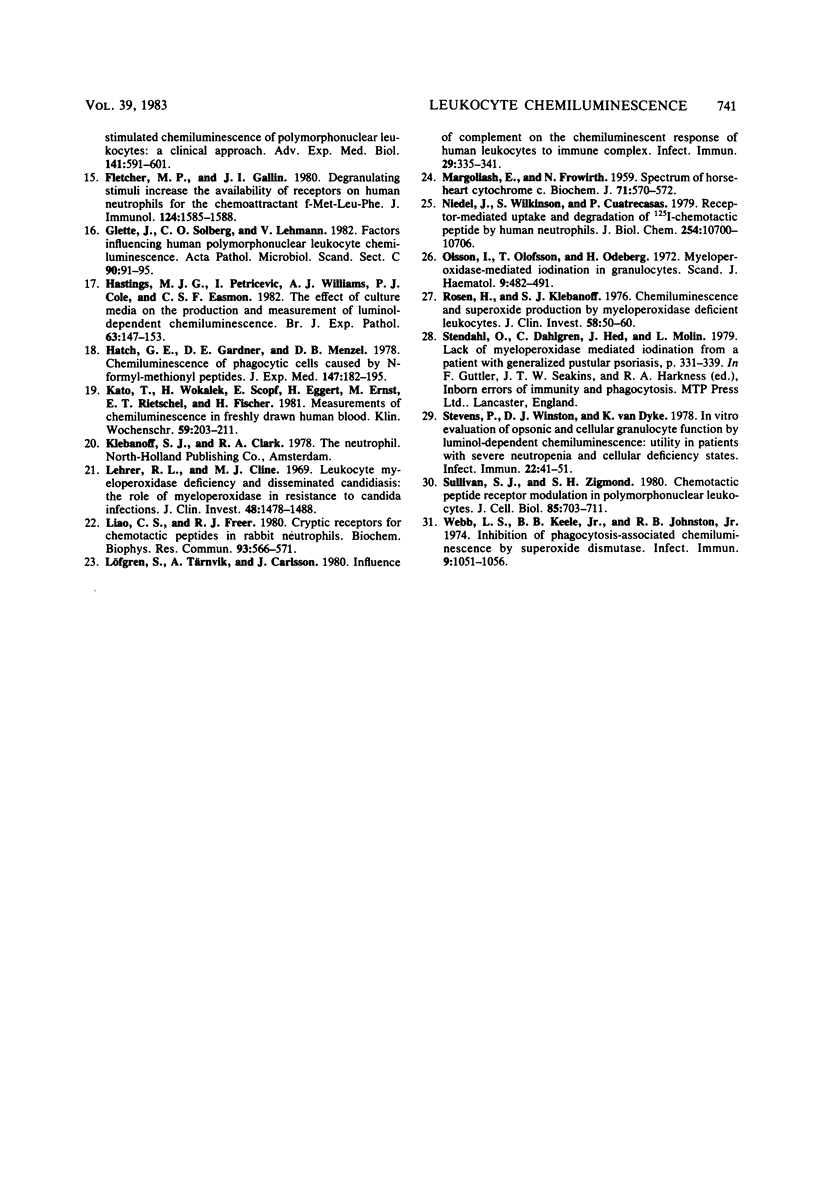
Selected References
These references are in PubMed. This may not be the complete list of references from this article.
- Allen R. C., Stjernholm R. L., Steele R. H. Evidence for the generation of an electronic excitation state(s) in human polymorphonuclear leukocytes and its participation in bactericidal activity. Biochem Biophys Res Commun. 1972 May 26;47(4):679–684. doi: 10.1016/0006-291x(72)90545-1. [DOI] [PubMed] [Google Scholar]
- Allred C. D., Hill H. R. Effect of chemoattractants on chemiluminescence. Infect Immun. 1978 Mar;19(3):833–838. doi: 10.1128/iai.19.3.833-838.1978. [DOI] [PMC free article] [PubMed] [Google Scholar]
- Andersen B. R., Amirault H. J. Important variables in granulocyte chemiluminescence. Proc Soc Exp Biol Med. 1979 Oct;162(1):139–145. doi: 10.3181/00379727-162-40633. [DOI] [PubMed] [Google Scholar]
- Anderson R., Gatner E. M., van Rensburg C. E., Grabow G., Imkamp F. M., Kok S. K., van Rensburg A. J. In vitro and in vivo effects of dapsone on neutrophil and lymphocyte functions in normal individuals and patients with lepromatous leprosy. Antimicrob Agents Chemother. 1981 Apr;19(4):495–503. doi: 10.1128/aac.19.4.495. [DOI] [PMC free article] [PubMed] [Google Scholar]
- Baehner R. L., Boxer L. A., Allen J. M., Davis J. Autooxidation as a basis for altered function by polymorphonuclear leukocytes. Blood. 1977 Aug;50(2):327–335. [PubMed] [Google Scholar]
- Beswick P. H., Kay A. B. The effects of an ECF-A and formyl methionyl chemotactic peptides on oxidative metabolism of human eosinophils and neutrophils. Clin Exp Immunol. 1981 Feb;43(2):399–407. [PMC free article] [PubMed] [Google Scholar]
- Böyum A. Isolation of mononuclear cells and granulocytes from human blood. Isolation of monuclear cells by one centrifugation, and of granulocytes by combining centrifugation and sedimentation at 1 g. Scand J Clin Lab Invest Suppl. 1968;97:77–89. [PubMed] [Google Scholar]
- Cheson B. D., Christensen R. L., Sperling R., Kohler B. E., Babior B. M. The origin of the chemiluminescence of phagocytosing granulocytes. J Clin Invest. 1976 Oct;58(4):789–796. doi: 10.1172/JCI108530. [DOI] [PMC free article] [PubMed] [Google Scholar]
- Clark R. A., Szot S., Venkatasubramanian K., Schiffmann E. Chemotactic factor inactivation by myeloperoxidase-mediated oxidation of methionine. J Immunol. 1980 Apr;124(4):2020–2026. [PubMed] [Google Scholar]
- Cohen H. J., Chovaniec M. E. Superoxide generation by digitonin-stimulated guinea pig granulocytes. A basis for a continuous assay for monitoring superoxide production and for the study of the activation of the generating system. J Clin Invest. 1978 Apr;61(4):1081–1087. doi: 10.1172/JCI109007. [DOI] [PMC free article] [PubMed] [Google Scholar]
- Dahlgren C., Magnusson K. E., Stendahl O., Sundqvist T. Modulation of polymorphonuclear leukocyte chemiluminescent response to the chemoattractant f-Met-Leu-Phe. Int Arch Allergy Appl Immunol. 1982;68(1):79–83. doi: 10.1159/000233070. [DOI] [PubMed] [Google Scholar]
- Dahlgren C., Stendahl O. Effect of in vitro preincubation of polymorphonuclear leukocytes on formylmethionyl-leucyl-phenylalanine-induced chemiluminescence. Infect Immun. 1982 Jul;37(1):34–39. doi: 10.1128/iai.37.1.34-39.1982. [DOI] [PMC free article] [PubMed] [Google Scholar]
- De Sole P., Lippa S., Littarru G. P. Resting and stimulated chemiluminescence of polymorphonuclear leukocytes: a clinical approach. Adv Exp Med Biol. 1982;141:591–601. doi: 10.1007/978-1-4684-8088-7_58. [DOI] [PubMed] [Google Scholar]
- DeChatelet L. R., Long G. D., Shirley P. S., Bass D. A., Thomas M. J., Henderson F. W., Cohen M. S. Mechanism of the luminol-dependent chemiluminescence of human neutrophils. J Immunol. 1982 Oct;129(4):1589–1593. [PubMed] [Google Scholar]
- Fletcher M. P., Gallin J. I. Degranulating stimuli increase the availability of receptors on human neutrophils for the chemoattractant f-met-leu-phe. J Immunol. 1980 Apr;124(4):1585–1588. [PubMed] [Google Scholar]
- Glette J., Solberg C. O., Lehmann V. Factors influencing human polymorphonuclear leukocyte chemiluminescence. Acta Pathol Microbiol Immunol Scand C. 1982 Apr;90(2):91–95. doi: 10.1111/j.1699-0463.1982.tb01423.x. [DOI] [PubMed] [Google Scholar]
- Hastings M. J., Petricevic I., Williams A. J., Cole P. J., Easmon C. S. The effect of culture media on the production and measurement of luminol-dependent chemiluminescence. Br J Exp Pathol. 1982 Apr;63(2):147–153. [PMC free article] [PubMed] [Google Scholar]
- Hatch G. E., Gardner D. E., Menzel D. B. Chemiluminescence of phagocytic cells caused by N-formylmethionyl peptides. J Exp Med. 1978 Jan 1;147(1):182–195. doi: 10.1084/jem.147.1.182. [DOI] [PMC free article] [PubMed] [Google Scholar]
- Kato T., Wokalek H., Schöpf E., Eggert H., Ernst M., Rietschel E. T., Fischer H. Measurement of chemiluminescence in freshly drawn human blood. I. Role of granulocytes, platelets, and plasma factors in zymosan-induced chemiluminescence. Klin Wochenschr. 1981 Mar 2;59(5):203–221. doi: 10.1007/BF01476577. [DOI] [PubMed] [Google Scholar]
- Liao C. S., Freer R. J. Cryptic receptors for chemotactic peptides in rabbit neutrophils. Biochem Biophys Res Commun. 1980 Mar 28;93(2):566–571. doi: 10.1016/0006-291x(80)91114-6. [DOI] [PubMed] [Google Scholar]
- Löfgren S., Tärnvik A., Carlsson J. Influence of complement on the chemiluminescent response of human leukocytes to immune complex. Infect Immun. 1980 Aug;29(2):335–341. doi: 10.1128/iai.29.2.335-341.1980. [DOI] [PMC free article] [PubMed] [Google Scholar]
- MARGOLIASH E., FROHWIRT N. Spectrum of horse-heart cytochrome c. Biochem J. 1959 Mar;71(3):570–572. doi: 10.1042/bj0710570. [DOI] [PMC free article] [PubMed] [Google Scholar]
- Niedel J., Wilkinson S., Cuatrecasas P. Receptor-mediated uptake and degradation of 125I-chemotactic peptide by human neutrophils. J Biol Chem. 1979 Nov 10;254(21):10700–10706. [PubMed] [Google Scholar]
- Olsson I., Olofsson T., Odeberg H. Myeloperoxidase-mediated iodination in granulocytes. Scand J Haematol. 1972;9(5):483–491. doi: 10.1111/j.1600-0609.1972.tb00974.x. [DOI] [PubMed] [Google Scholar]
- Rosen H., Klebanoff S. J. Chemiluminescence and superoxide production by myeloperoxidase-deficient leukocytes. J Clin Invest. 1976 Jul;58(1):50–60. doi: 10.1172/JCI108458. [DOI] [PMC free article] [PubMed] [Google Scholar]
- Stevens P., Winston D. J., Van Dyke K. In vitro evaluation of opsonic and cellular granulocyte function by luminol-dependent chemiluminescence: utility in patients with severe neutropenia and cellular deficiency states. Infect Immun. 1978 Oct;22(1):41–51. doi: 10.1128/iai.22.1.41-51.1978. [DOI] [PMC free article] [PubMed] [Google Scholar]
- Sullivan S. J., Zigmond S. H. Chemotactic peptide receptor modulation in polymorphonuclear leukocytes. J Cell Biol. 1980 Jun;85(3):703–711. doi: 10.1083/jcb.85.3.703. [DOI] [PMC free article] [PubMed] [Google Scholar]
- Webb L. S., Keele B. B., Jr, Johnston R. B., Jr Inhibition of phagocytosis-associated chemiluminescence by superoxide dismutase. Infect Immun. 1974 Jun;9(6):1051–1056. doi: 10.1128/iai.9.6.1051-1056.1974. [DOI] [PMC free article] [PubMed] [Google Scholar]


